Quality Improvement in Patient Safety: Role of a Nurse Manager
VerifiedAdded on 2022/11/16
|10
|4197
|304
Report
AI Summary
This report delves into the critical aspects of quality improvement in patient safety, focusing on the role of a nurse manager within a hospital setting. It explores various strategies to enhance patient safety, including the prevention of bloodstream infections through meticulous catheter care and the use of chlorhexidine. The report also addresses the importance of re-engineering hospital discharge processes to ensure clear medication schedules and follow-up appointments, as well as the prevention of venous thromboembolism through careful patient monitoring and mobility support. Furthermore, it emphasizes the significance of physical separation of patients with airborne diseases, staff awareness training, and the importance of limiting shift durations to prevent burnout and errors. The report also highlights the value of patient safety organizations, the use of visual warning systems like CCTV, and the need for improved hospital design, including separate pharmacies and robust cybersecurity measures. The goal is to provide a comprehensive overview of how to foster a safer and more efficient healthcare environment.
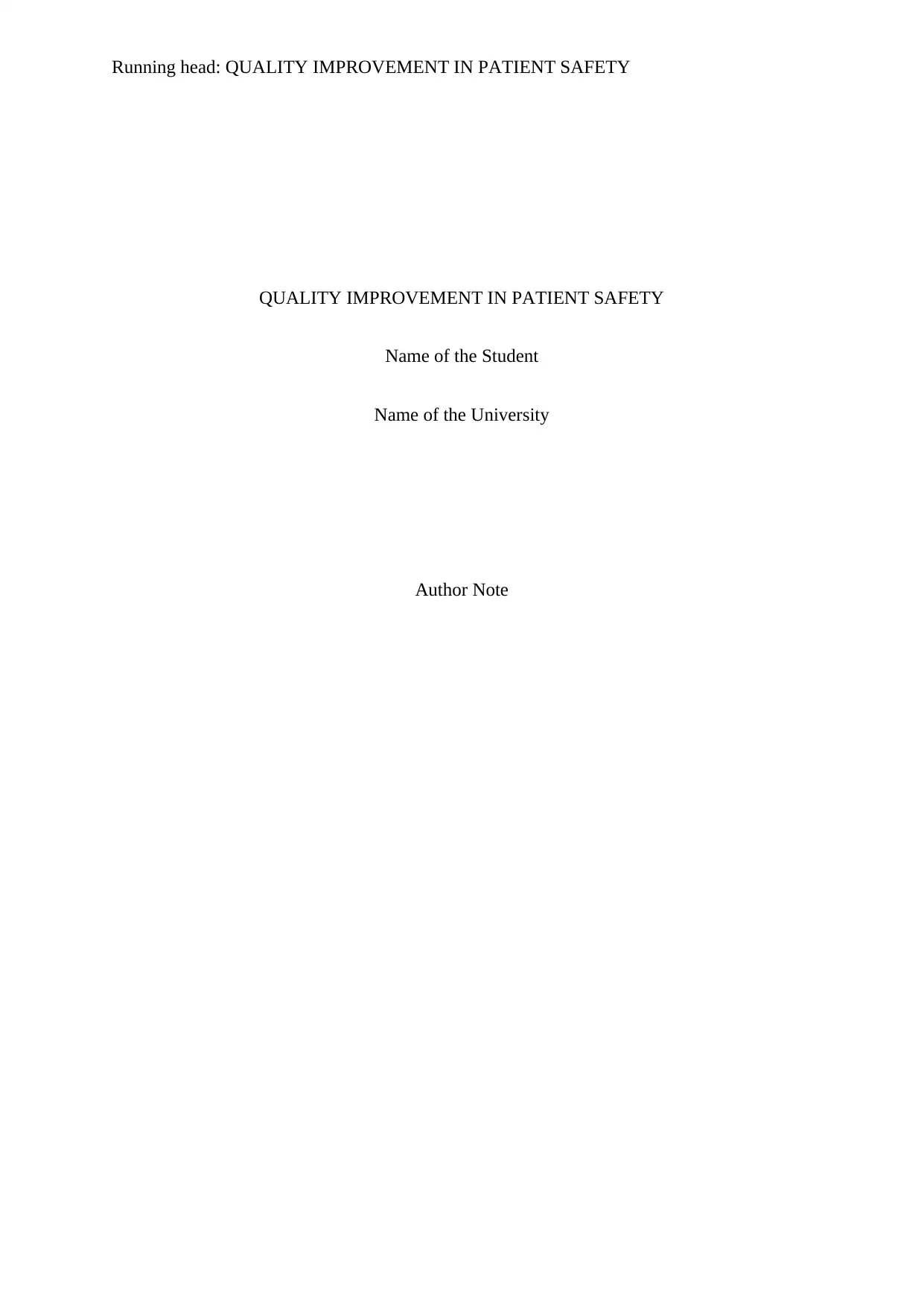
Running head: QUALITY IMPROVEMENT IN PATIENT SAFETY
QUALITY IMPROVEMENT IN PATIENT SAFETY
Name of the Student
Name of the University
Author Note
QUALITY IMPROVEMENT IN PATIENT SAFETY
Name of the Student
Name of the University
Author Note
Paraphrase This Document
Need a fresh take? Get an instant paraphrase of this document with our AI Paraphraser
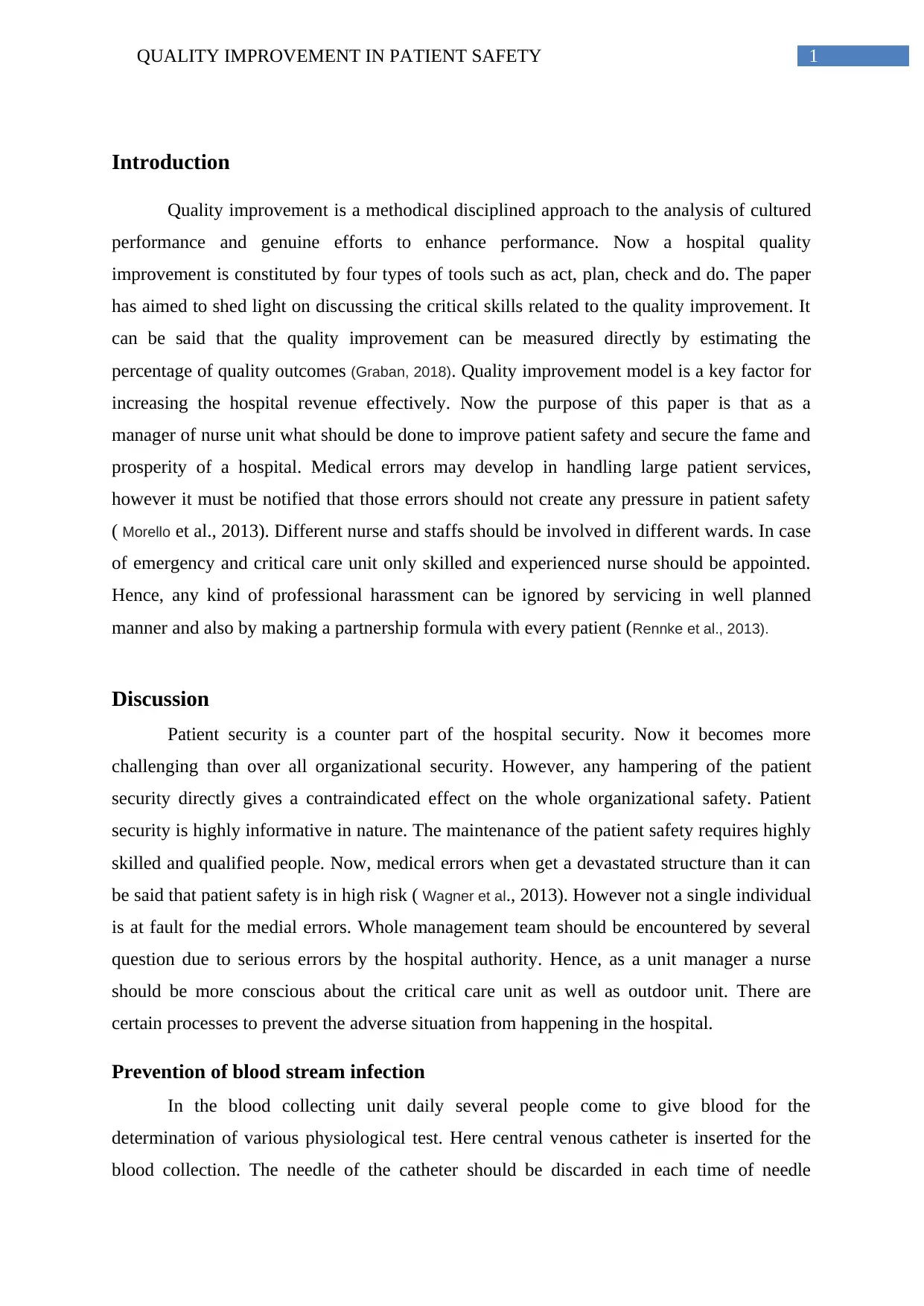
1QUALITY IMPROVEMENT IN PATIENT SAFETY
Introduction
Quality improvement is a methodical disciplined approach to the analysis of cultured
performance and genuine efforts to enhance performance. Now a hospital quality
improvement is constituted by four types of tools such as act, plan, check and do. The paper
has aimed to shed light on discussing the critical skills related to the quality improvement. It
can be said that the quality improvement can be measured directly by estimating the
percentage of quality outcomes (Graban, 2018). Quality improvement model is a key factor for
increasing the hospital revenue effectively. Now the purpose of this paper is that as a
manager of nurse unit what should be done to improve patient safety and secure the fame and
prosperity of a hospital. Medical errors may develop in handling large patient services,
however it must be notified that those errors should not create any pressure in patient safety
( Morello et al., 2013). Different nurse and staffs should be involved in different wards. In case
of emergency and critical care unit only skilled and experienced nurse should be appointed.
Hence, any kind of professional harassment can be ignored by servicing in well planned
manner and also by making a partnership formula with every patient (Rennke et al., 2013).
Discussion
Patient security is a counter part of the hospital security. Now it becomes more
challenging than over all organizational security. However, any hampering of the patient
security directly gives a contraindicated effect on the whole organizational safety. Patient
security is highly informative in nature. The maintenance of the patient safety requires highly
skilled and qualified people. Now, medical errors when get a devastated structure than it can
be said that patient safety is in high risk ( Wagner et al., 2013). However not a single individual
is at fault for the medial errors. Whole management team should be encountered by several
question due to serious errors by the hospital authority. Hence, as a unit manager a nurse
should be more conscious about the critical care unit as well as outdoor unit. There are
certain processes to prevent the adverse situation from happening in the hospital.
Prevention of blood stream infection
In the blood collecting unit daily several people come to give blood for the
determination of various physiological test. Here central venous catheter is inserted for the
blood collection. The needle of the catheter should be discarded in each time of needle
Introduction
Quality improvement is a methodical disciplined approach to the analysis of cultured
performance and genuine efforts to enhance performance. Now a hospital quality
improvement is constituted by four types of tools such as act, plan, check and do. The paper
has aimed to shed light on discussing the critical skills related to the quality improvement. It
can be said that the quality improvement can be measured directly by estimating the
percentage of quality outcomes (Graban, 2018). Quality improvement model is a key factor for
increasing the hospital revenue effectively. Now the purpose of this paper is that as a
manager of nurse unit what should be done to improve patient safety and secure the fame and
prosperity of a hospital. Medical errors may develop in handling large patient services,
however it must be notified that those errors should not create any pressure in patient safety
( Morello et al., 2013). Different nurse and staffs should be involved in different wards. In case
of emergency and critical care unit only skilled and experienced nurse should be appointed.
Hence, any kind of professional harassment can be ignored by servicing in well planned
manner and also by making a partnership formula with every patient (Rennke et al., 2013).
Discussion
Patient security is a counter part of the hospital security. Now it becomes more
challenging than over all organizational security. However, any hampering of the patient
security directly gives a contraindicated effect on the whole organizational safety. Patient
security is highly informative in nature. The maintenance of the patient safety requires highly
skilled and qualified people. Now, medical errors when get a devastated structure than it can
be said that patient safety is in high risk ( Wagner et al., 2013). However not a single individual
is at fault for the medial errors. Whole management team should be encountered by several
question due to serious errors by the hospital authority. Hence, as a unit manager a nurse
should be more conscious about the critical care unit as well as outdoor unit. There are
certain processes to prevent the adverse situation from happening in the hospital.
Prevention of blood stream infection
In the blood collecting unit daily several people come to give blood for the
determination of various physiological test. Here central venous catheter is inserted for the
blood collection. The needle of the catheter should be discarded in each time of needle
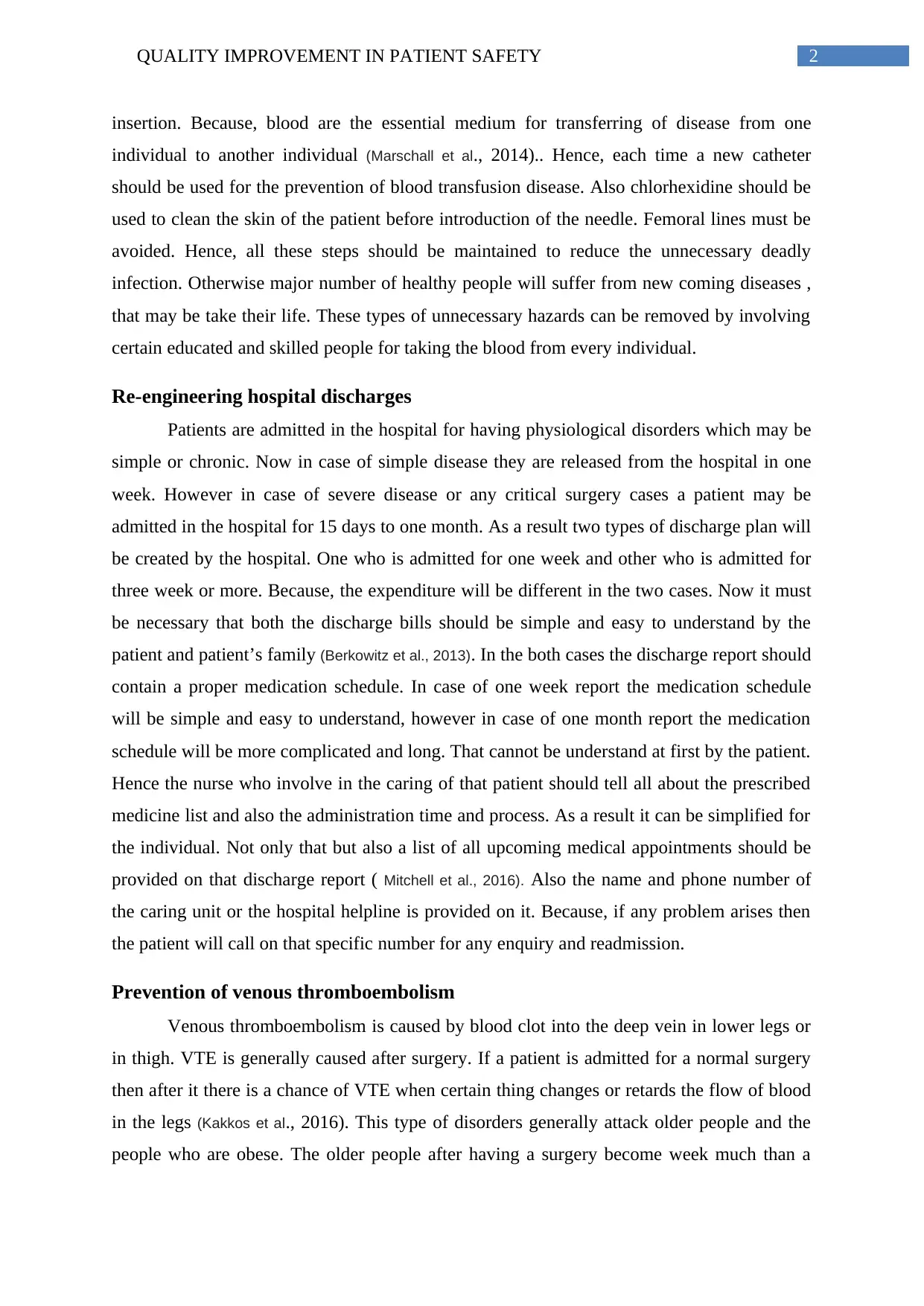
2QUALITY IMPROVEMENT IN PATIENT SAFETY
insertion. Because, blood are the essential medium for transferring of disease from one
individual to another individual (Marschall et al., 2014).. Hence, each time a new catheter
should be used for the prevention of blood transfusion disease. Also chlorhexidine should be
used to clean the skin of the patient before introduction of the needle. Femoral lines must be
avoided. Hence, all these steps should be maintained to reduce the unnecessary deadly
infection. Otherwise major number of healthy people will suffer from new coming diseases ,
that may be take their life. These types of unnecessary hazards can be removed by involving
certain educated and skilled people for taking the blood from every individual.
Re-engineering hospital discharges
Patients are admitted in the hospital for having physiological disorders which may be
simple or chronic. Now in case of simple disease they are released from the hospital in one
week. However in case of severe disease or any critical surgery cases a patient may be
admitted in the hospital for 15 days to one month. As a result two types of discharge plan will
be created by the hospital. One who is admitted for one week and other who is admitted for
three week or more. Because, the expenditure will be different in the two cases. Now it must
be necessary that both the discharge bills should be simple and easy to understand by the
patient and patient’s family (Berkowitz et al., 2013). In the both cases the discharge report should
contain a proper medication schedule. In case of one week report the medication schedule
will be simple and easy to understand, however in case of one month report the medication
schedule will be more complicated and long. That cannot be understand at first by the patient.
Hence the nurse who involve in the caring of that patient should tell all about the prescribed
medicine list and also the administration time and process. As a result it can be simplified for
the individual. Not only that but also a list of all upcoming medical appointments should be
provided on that discharge report ( Mitchell et al., 2016). Also the name and phone number of
the caring unit or the hospital helpline is provided on it. Because, if any problem arises then
the patient will call on that specific number for any enquiry and readmission.
Prevention of venous thromboembolism
Venous thromboembolism is caused by blood clot into the deep vein in lower legs or
in thigh. VTE is generally caused after surgery. If a patient is admitted for a normal surgery
then after it there is a chance of VTE when certain thing changes or retards the flow of blood
in the legs (Kakkos et al., 2016). This type of disorders generally attack older people and the
people who are obese. The older people after having a surgery become week much than a
insertion. Because, blood are the essential medium for transferring of disease from one
individual to another individual (Marschall et al., 2014).. Hence, each time a new catheter
should be used for the prevention of blood transfusion disease. Also chlorhexidine should be
used to clean the skin of the patient before introduction of the needle. Femoral lines must be
avoided. Hence, all these steps should be maintained to reduce the unnecessary deadly
infection. Otherwise major number of healthy people will suffer from new coming diseases ,
that may be take their life. These types of unnecessary hazards can be removed by involving
certain educated and skilled people for taking the blood from every individual.
Re-engineering hospital discharges
Patients are admitted in the hospital for having physiological disorders which may be
simple or chronic. Now in case of simple disease they are released from the hospital in one
week. However in case of severe disease or any critical surgery cases a patient may be
admitted in the hospital for 15 days to one month. As a result two types of discharge plan will
be created by the hospital. One who is admitted for one week and other who is admitted for
three week or more. Because, the expenditure will be different in the two cases. Now it must
be necessary that both the discharge bills should be simple and easy to understand by the
patient and patient’s family (Berkowitz et al., 2013). In the both cases the discharge report should
contain a proper medication schedule. In case of one week report the medication schedule
will be simple and easy to understand, however in case of one month report the medication
schedule will be more complicated and long. That cannot be understand at first by the patient.
Hence the nurse who involve in the caring of that patient should tell all about the prescribed
medicine list and also the administration time and process. As a result it can be simplified for
the individual. Not only that but also a list of all upcoming medical appointments should be
provided on that discharge report ( Mitchell et al., 2016). Also the name and phone number of
the caring unit or the hospital helpline is provided on it. Because, if any problem arises then
the patient will call on that specific number for any enquiry and readmission.
Prevention of venous thromboembolism
Venous thromboembolism is caused by blood clot into the deep vein in lower legs or
in thigh. VTE is generally caused after surgery. If a patient is admitted for a normal surgery
then after it there is a chance of VTE when certain thing changes or retards the flow of blood
in the legs (Kakkos et al., 2016). This type of disorders generally attack older people and the
people who are obese. The older people after having a surgery become week much than a
⊘ This is a preview!⊘
Do you want full access?
Subscribe today to unlock all pages.

Trusted by 1+ million students worldwide
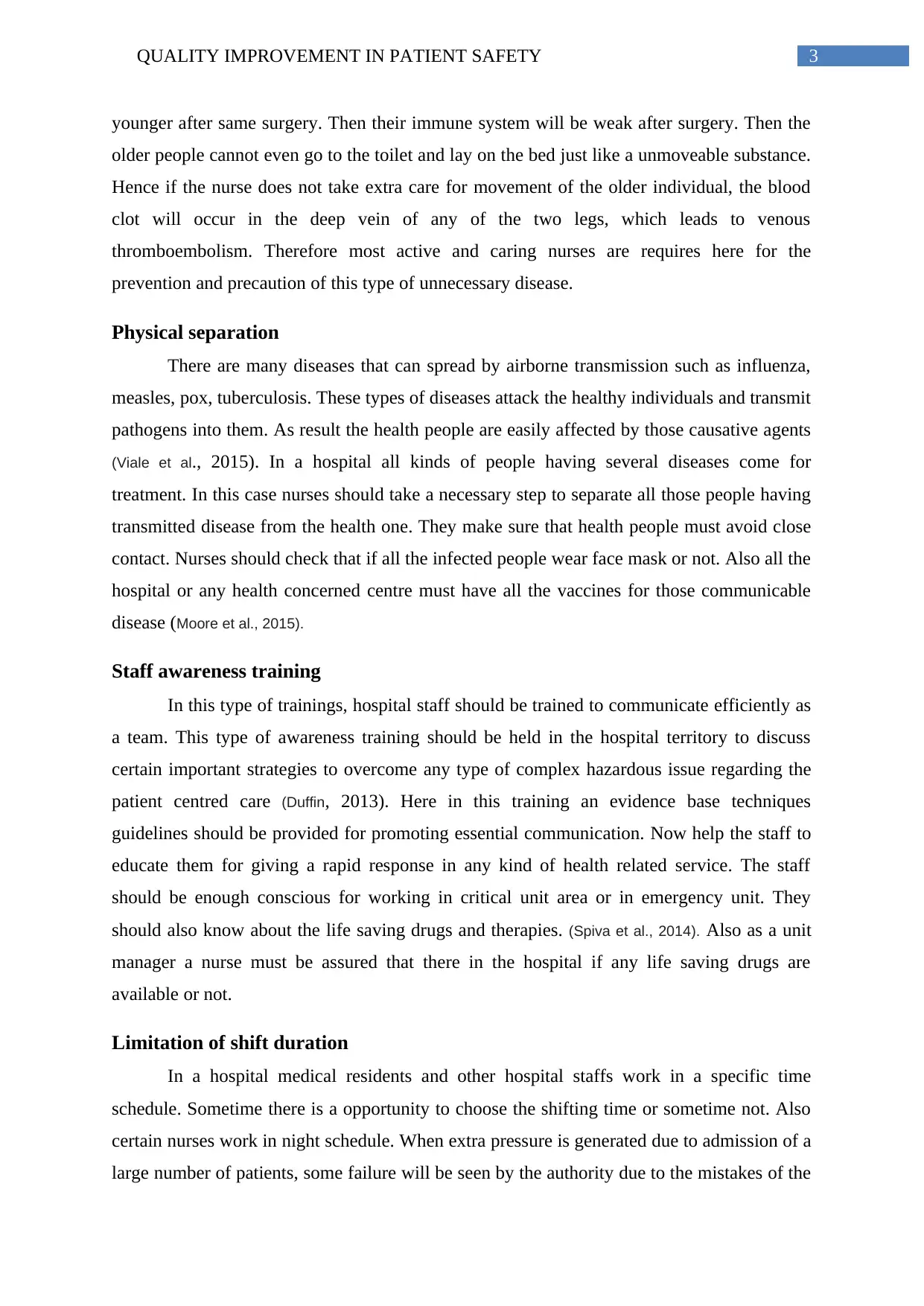
3QUALITY IMPROVEMENT IN PATIENT SAFETY
younger after same surgery. Then their immune system will be weak after surgery. Then the
older people cannot even go to the toilet and lay on the bed just like a unmoveable substance.
Hence if the nurse does not take extra care for movement of the older individual, the blood
clot will occur in the deep vein of any of the two legs, which leads to venous
thromboembolism. Therefore most active and caring nurses are requires here for the
prevention and precaution of this type of unnecessary disease.
Physical separation
There are many diseases that can spread by airborne transmission such as influenza,
measles, pox, tuberculosis. These types of diseases attack the healthy individuals and transmit
pathogens into them. As result the health people are easily affected by those causative agents
(Viale et al., 2015). In a hospital all kinds of people having several diseases come for
treatment. In this case nurses should take a necessary step to separate all those people having
transmitted disease from the health one. They make sure that health people must avoid close
contact. Nurses should check that if all the infected people wear face mask or not. Also all the
hospital or any health concerned centre must have all the vaccines for those communicable
disease (Moore et al., 2015).
Staff awareness training
In this type of trainings, hospital staff should be trained to communicate efficiently as
a team. This type of awareness training should be held in the hospital territory to discuss
certain important strategies to overcome any type of complex hazardous issue regarding the
patient centred care (Duffin, 2013). Here in this training an evidence base techniques
guidelines should be provided for promoting essential communication. Now help the staff to
educate them for giving a rapid response in any kind of health related service. The staff
should be enough conscious for working in critical unit area or in emergency unit. They
should also know about the life saving drugs and therapies. (Spiva et al., 2014). Also as a unit
manager a nurse must be assured that there in the hospital if any life saving drugs are
available or not.
Limitation of shift duration
In a hospital medical residents and other hospital staffs work in a specific time
schedule. Sometime there is a opportunity to choose the shifting time or sometime not. Also
certain nurses work in night schedule. When extra pressure is generated due to admission of a
large number of patients, some failure will be seen by the authority due to the mistakes of the
younger after same surgery. Then their immune system will be weak after surgery. Then the
older people cannot even go to the toilet and lay on the bed just like a unmoveable substance.
Hence if the nurse does not take extra care for movement of the older individual, the blood
clot will occur in the deep vein of any of the two legs, which leads to venous
thromboembolism. Therefore most active and caring nurses are requires here for the
prevention and precaution of this type of unnecessary disease.
Physical separation
There are many diseases that can spread by airborne transmission such as influenza,
measles, pox, tuberculosis. These types of diseases attack the healthy individuals and transmit
pathogens into them. As result the health people are easily affected by those causative agents
(Viale et al., 2015). In a hospital all kinds of people having several diseases come for
treatment. In this case nurses should take a necessary step to separate all those people having
transmitted disease from the health one. They make sure that health people must avoid close
contact. Nurses should check that if all the infected people wear face mask or not. Also all the
hospital or any health concerned centre must have all the vaccines for those communicable
disease (Moore et al., 2015).
Staff awareness training
In this type of trainings, hospital staff should be trained to communicate efficiently as
a team. This type of awareness training should be held in the hospital territory to discuss
certain important strategies to overcome any type of complex hazardous issue regarding the
patient centred care (Duffin, 2013). Here in this training an evidence base techniques
guidelines should be provided for promoting essential communication. Now help the staff to
educate them for giving a rapid response in any kind of health related service. The staff
should be enough conscious for working in critical unit area or in emergency unit. They
should also know about the life saving drugs and therapies. (Spiva et al., 2014). Also as a unit
manager a nurse must be assured that there in the hospital if any life saving drugs are
available or not.
Limitation of shift duration
In a hospital medical residents and other hospital staffs work in a specific time
schedule. Sometime there is a opportunity to choose the shifting time or sometime not. Also
certain nurses work in night schedule. When extra pressure is generated due to admission of a
large number of patients, some failure will be seen by the authority due to the mistakes of the
Paraphrase This Document
Need a fresh take? Get an instant paraphrase of this document with our AI Paraphraser
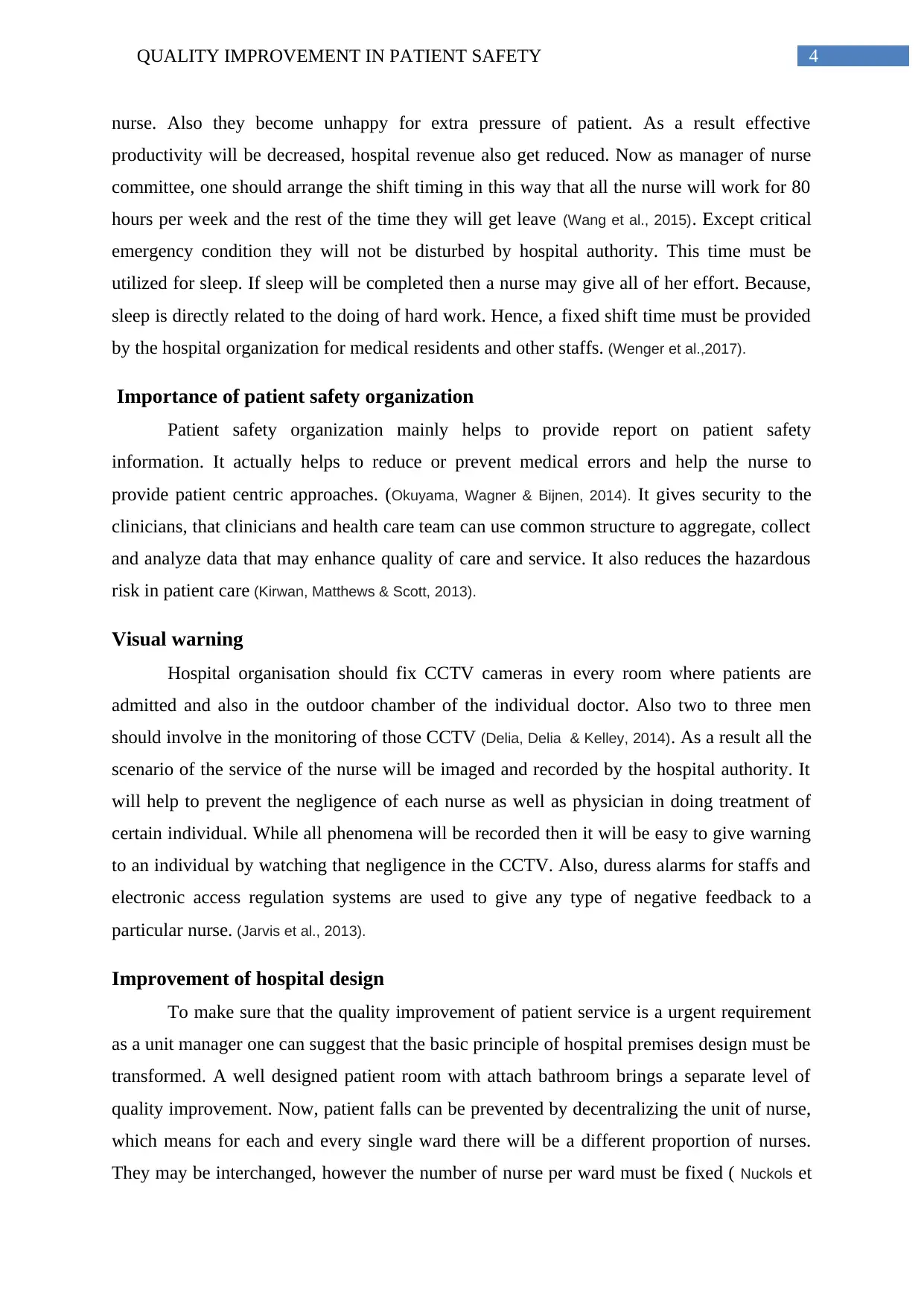
4QUALITY IMPROVEMENT IN PATIENT SAFETY
nurse. Also they become unhappy for extra pressure of patient. As a result effective
productivity will be decreased, hospital revenue also get reduced. Now as manager of nurse
committee, one should arrange the shift timing in this way that all the nurse will work for 80
hours per week and the rest of the time they will get leave (Wang et al., 2015). Except critical
emergency condition they will not be disturbed by hospital authority. This time must be
utilized for sleep. If sleep will be completed then a nurse may give all of her effort. Because,
sleep is directly related to the doing of hard work. Hence, a fixed shift time must be provided
by the hospital organization for medical residents and other staffs. (Wenger et al.,2017).
Importance of patient safety organization
Patient safety organization mainly helps to provide report on patient safety
information. It actually helps to reduce or prevent medical errors and help the nurse to
provide patient centric approaches. (Okuyama, Wagner & Bijnen, 2014). It gives security to the
clinicians, that clinicians and health care team can use common structure to aggregate, collect
and analyze data that may enhance quality of care and service. It also reduces the hazardous
risk in patient care (Kirwan, Matthews & Scott, 2013).
Visual warning
Hospital organisation should fix CCTV cameras in every room where patients are
admitted and also in the outdoor chamber of the individual doctor. Also two to three men
should involve in the monitoring of those CCTV (Delia, Delia & Kelley, 2014). As a result all the
scenario of the service of the nurse will be imaged and recorded by the hospital authority. It
will help to prevent the negligence of each nurse as well as physician in doing treatment of
certain individual. While all phenomena will be recorded then it will be easy to give warning
to an individual by watching that negligence in the CCTV. Also, duress alarms for staffs and
electronic access regulation systems are used to give any type of negative feedback to a
particular nurse. (Jarvis et al., 2013).
Improvement of hospital design
To make sure that the quality improvement of patient service is a urgent requirement
as a unit manager one can suggest that the basic principle of hospital premises design must be
transformed. A well designed patient room with attach bathroom brings a separate level of
quality improvement. Now, patient falls can be prevented by decentralizing the unit of nurse,
which means for each and every single ward there will be a different proportion of nurses.
They may be interchanged, however the number of nurse per ward must be fixed ( Nuckols et
nurse. Also they become unhappy for extra pressure of patient. As a result effective
productivity will be decreased, hospital revenue also get reduced. Now as manager of nurse
committee, one should arrange the shift timing in this way that all the nurse will work for 80
hours per week and the rest of the time they will get leave (Wang et al., 2015). Except critical
emergency condition they will not be disturbed by hospital authority. This time must be
utilized for sleep. If sleep will be completed then a nurse may give all of her effort. Because,
sleep is directly related to the doing of hard work. Hence, a fixed shift time must be provided
by the hospital organization for medical residents and other staffs. (Wenger et al.,2017).
Importance of patient safety organization
Patient safety organization mainly helps to provide report on patient safety
information. It actually helps to reduce or prevent medical errors and help the nurse to
provide patient centric approaches. (Okuyama, Wagner & Bijnen, 2014). It gives security to the
clinicians, that clinicians and health care team can use common structure to aggregate, collect
and analyze data that may enhance quality of care and service. It also reduces the hazardous
risk in patient care (Kirwan, Matthews & Scott, 2013).
Visual warning
Hospital organisation should fix CCTV cameras in every room where patients are
admitted and also in the outdoor chamber of the individual doctor. Also two to three men
should involve in the monitoring of those CCTV (Delia, Delia & Kelley, 2014). As a result all the
scenario of the service of the nurse will be imaged and recorded by the hospital authority. It
will help to prevent the negligence of each nurse as well as physician in doing treatment of
certain individual. While all phenomena will be recorded then it will be easy to give warning
to an individual by watching that negligence in the CCTV. Also, duress alarms for staffs and
electronic access regulation systems are used to give any type of negative feedback to a
particular nurse. (Jarvis et al., 2013).
Improvement of hospital design
To make sure that the quality improvement of patient service is a urgent requirement
as a unit manager one can suggest that the basic principle of hospital premises design must be
transformed. A well designed patient room with attach bathroom brings a separate level of
quality improvement. Now, patient falls can be prevented by decentralizing the unit of nurse,
which means for each and every single ward there will be a different proportion of nurses.
They may be interchanged, however the number of nurse per ward must be fixed ( Nuckols et
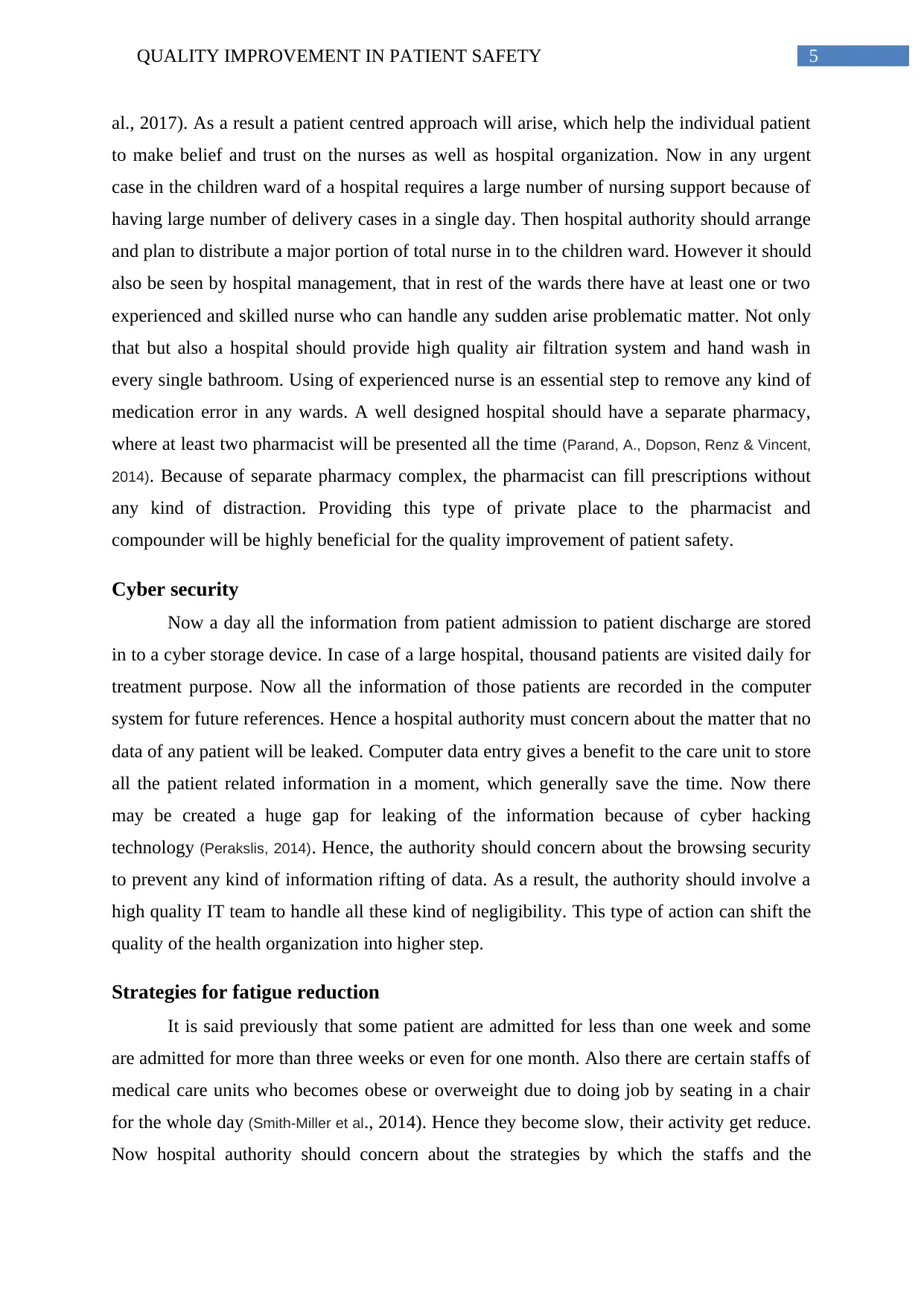
5QUALITY IMPROVEMENT IN PATIENT SAFETY
al., 2017). As a result a patient centred approach will arise, which help the individual patient
to make belief and trust on the nurses as well as hospital organization. Now in any urgent
case in the children ward of a hospital requires a large number of nursing support because of
having large number of delivery cases in a single day. Then hospital authority should arrange
and plan to distribute a major portion of total nurse in to the children ward. However it should
also be seen by hospital management, that in rest of the wards there have at least one or two
experienced and skilled nurse who can handle any sudden arise problematic matter. Not only
that but also a hospital should provide high quality air filtration system and hand wash in
every single bathroom. Using of experienced nurse is an essential step to remove any kind of
medication error in any wards. A well designed hospital should have a separate pharmacy,
where at least two pharmacist will be presented all the time (Parand, A., Dopson, Renz & Vincent,
2014). Because of separate pharmacy complex, the pharmacist can fill prescriptions without
any kind of distraction. Providing this type of private place to the pharmacist and
compounder will be highly beneficial for the quality improvement of patient safety.
Cyber security
Now a day all the information from patient admission to patient discharge are stored
in to a cyber storage device. In case of a large hospital, thousand patients are visited daily for
treatment purpose. Now all the information of those patients are recorded in the computer
system for future references. Hence a hospital authority must concern about the matter that no
data of any patient will be leaked. Computer data entry gives a benefit to the care unit to store
all the patient related information in a moment, which generally save the time. Now there
may be created a huge gap for leaking of the information because of cyber hacking
technology (Perakslis, 2014). Hence, the authority should concern about the browsing security
to prevent any kind of information rifting of data. As a result, the authority should involve a
high quality IT team to handle all these kind of negligibility. This type of action can shift the
quality of the health organization into higher step.
Strategies for fatigue reduction
It is said previously that some patient are admitted for less than one week and some
are admitted for more than three weeks or even for one month. Also there are certain staffs of
medical care units who becomes obese or overweight due to doing job by seating in a chair
for the whole day (Smith-Miller et al., 2014). Hence they become slow, their activity get reduce.
Now hospital authority should concern about the strategies by which the staffs and the
al., 2017). As a result a patient centred approach will arise, which help the individual patient
to make belief and trust on the nurses as well as hospital organization. Now in any urgent
case in the children ward of a hospital requires a large number of nursing support because of
having large number of delivery cases in a single day. Then hospital authority should arrange
and plan to distribute a major portion of total nurse in to the children ward. However it should
also be seen by hospital management, that in rest of the wards there have at least one or two
experienced and skilled nurse who can handle any sudden arise problematic matter. Not only
that but also a hospital should provide high quality air filtration system and hand wash in
every single bathroom. Using of experienced nurse is an essential step to remove any kind of
medication error in any wards. A well designed hospital should have a separate pharmacy,
where at least two pharmacist will be presented all the time (Parand, A., Dopson, Renz & Vincent,
2014). Because of separate pharmacy complex, the pharmacist can fill prescriptions without
any kind of distraction. Providing this type of private place to the pharmacist and
compounder will be highly beneficial for the quality improvement of patient safety.
Cyber security
Now a day all the information from patient admission to patient discharge are stored
in to a cyber storage device. In case of a large hospital, thousand patients are visited daily for
treatment purpose. Now all the information of those patients are recorded in the computer
system for future references. Hence a hospital authority must concern about the matter that no
data of any patient will be leaked. Computer data entry gives a benefit to the care unit to store
all the patient related information in a moment, which generally save the time. Now there
may be created a huge gap for leaking of the information because of cyber hacking
technology (Perakslis, 2014). Hence, the authority should concern about the browsing security
to prevent any kind of information rifting of data. As a result, the authority should involve a
high quality IT team to handle all these kind of negligibility. This type of action can shift the
quality of the health organization into higher step.
Strategies for fatigue reduction
It is said previously that some patient are admitted for less than one week and some
are admitted for more than three weeks or even for one month. Also there are certain staffs of
medical care units who becomes obese or overweight due to doing job by seating in a chair
for the whole day (Smith-Miller et al., 2014). Hence they become slow, their activity get reduce.
Now hospital authority should concern about the strategies by which the staffs and the
⊘ This is a preview!⊘
Do you want full access?
Subscribe today to unlock all pages.

Trusted by 1+ million students worldwide
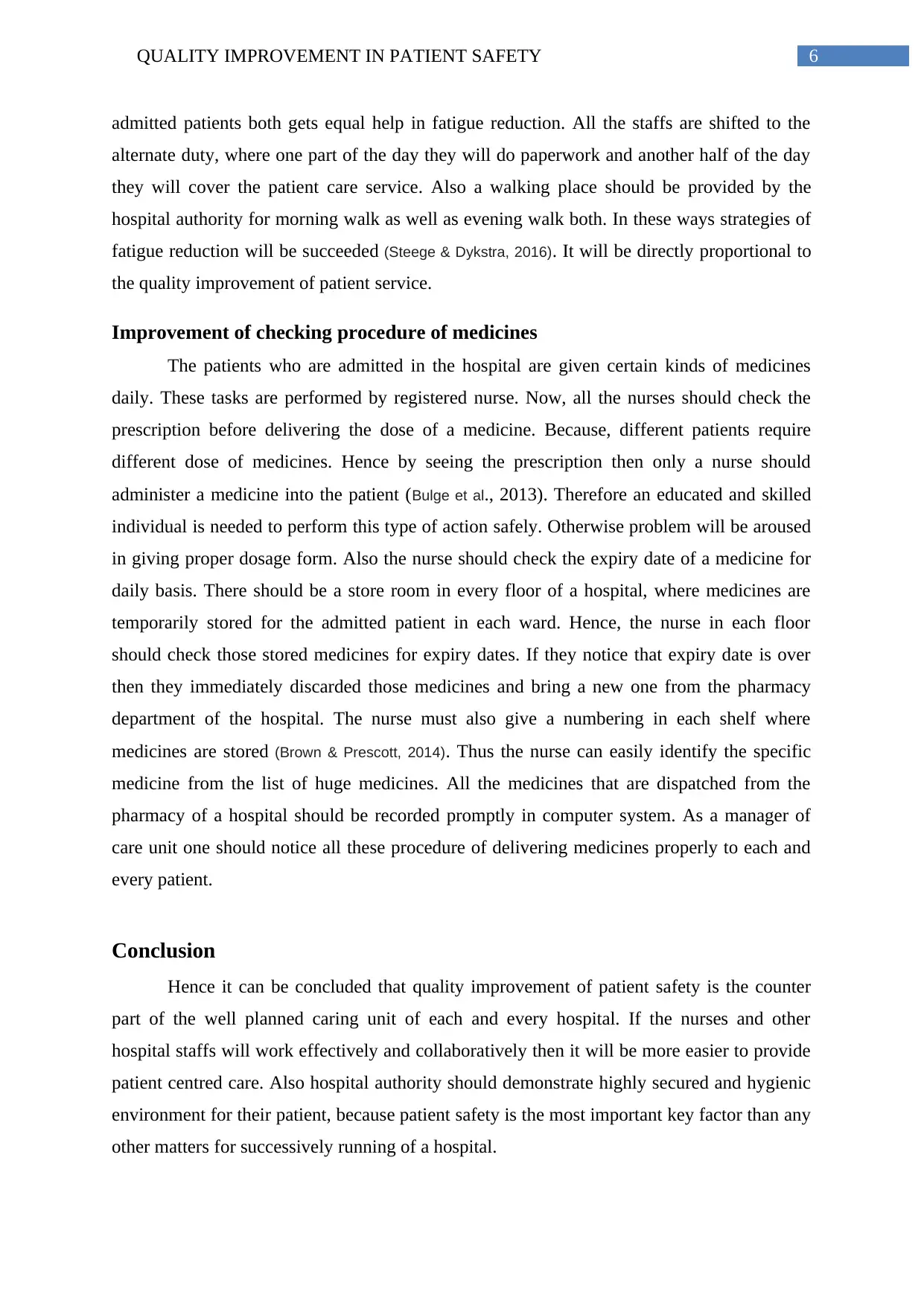
6QUALITY IMPROVEMENT IN PATIENT SAFETY
admitted patients both gets equal help in fatigue reduction. All the staffs are shifted to the
alternate duty, where one part of the day they will do paperwork and another half of the day
they will cover the patient care service. Also a walking place should be provided by the
hospital authority for morning walk as well as evening walk both. In these ways strategies of
fatigue reduction will be succeeded (Steege & Dykstra, 2016). It will be directly proportional to
the quality improvement of patient service.
Improvement of checking procedure of medicines
The patients who are admitted in the hospital are given certain kinds of medicines
daily. These tasks are performed by registered nurse. Now, all the nurses should check the
prescription before delivering the dose of a medicine. Because, different patients require
different dose of medicines. Hence by seeing the prescription then only a nurse should
administer a medicine into the patient (Bulge et al., 2013). Therefore an educated and skilled
individual is needed to perform this type of action safely. Otherwise problem will be aroused
in giving proper dosage form. Also the nurse should check the expiry date of a medicine for
daily basis. There should be a store room in every floor of a hospital, where medicines are
temporarily stored for the admitted patient in each ward. Hence, the nurse in each floor
should check those stored medicines for expiry dates. If they notice that expiry date is over
then they immediately discarded those medicines and bring a new one from the pharmacy
department of the hospital. The nurse must also give a numbering in each shelf where
medicines are stored (Brown & Prescott, 2014). Thus the nurse can easily identify the specific
medicine from the list of huge medicines. All the medicines that are dispatched from the
pharmacy of a hospital should be recorded promptly in computer system. As a manager of
care unit one should notice all these procedure of delivering medicines properly to each and
every patient.
Conclusion
Hence it can be concluded that quality improvement of patient safety is the counter
part of the well planned caring unit of each and every hospital. If the nurses and other
hospital staffs will work effectively and collaboratively then it will be more easier to provide
patient centred care. Also hospital authority should demonstrate highly secured and hygienic
environment for their patient, because patient safety is the most important key factor than any
other matters for successively running of a hospital.
admitted patients both gets equal help in fatigue reduction. All the staffs are shifted to the
alternate duty, where one part of the day they will do paperwork and another half of the day
they will cover the patient care service. Also a walking place should be provided by the
hospital authority for morning walk as well as evening walk both. In these ways strategies of
fatigue reduction will be succeeded (Steege & Dykstra, 2016). It will be directly proportional to
the quality improvement of patient service.
Improvement of checking procedure of medicines
The patients who are admitted in the hospital are given certain kinds of medicines
daily. These tasks are performed by registered nurse. Now, all the nurses should check the
prescription before delivering the dose of a medicine. Because, different patients require
different dose of medicines. Hence by seeing the prescription then only a nurse should
administer a medicine into the patient (Bulge et al., 2013). Therefore an educated and skilled
individual is needed to perform this type of action safely. Otherwise problem will be aroused
in giving proper dosage form. Also the nurse should check the expiry date of a medicine for
daily basis. There should be a store room in every floor of a hospital, where medicines are
temporarily stored for the admitted patient in each ward. Hence, the nurse in each floor
should check those stored medicines for expiry dates. If they notice that expiry date is over
then they immediately discarded those medicines and bring a new one from the pharmacy
department of the hospital. The nurse must also give a numbering in each shelf where
medicines are stored (Brown & Prescott, 2014). Thus the nurse can easily identify the specific
medicine from the list of huge medicines. All the medicines that are dispatched from the
pharmacy of a hospital should be recorded promptly in computer system. As a manager of
care unit one should notice all these procedure of delivering medicines properly to each and
every patient.
Conclusion
Hence it can be concluded that quality improvement of patient safety is the counter
part of the well planned caring unit of each and every hospital. If the nurses and other
hospital staffs will work effectively and collaboratively then it will be more easier to provide
patient centred care. Also hospital authority should demonstrate highly secured and hygienic
environment for their patient, because patient safety is the most important key factor than any
other matters for successively running of a hospital.
Paraphrase This Document
Need a fresh take? Get an instant paraphrase of this document with our AI Paraphraser
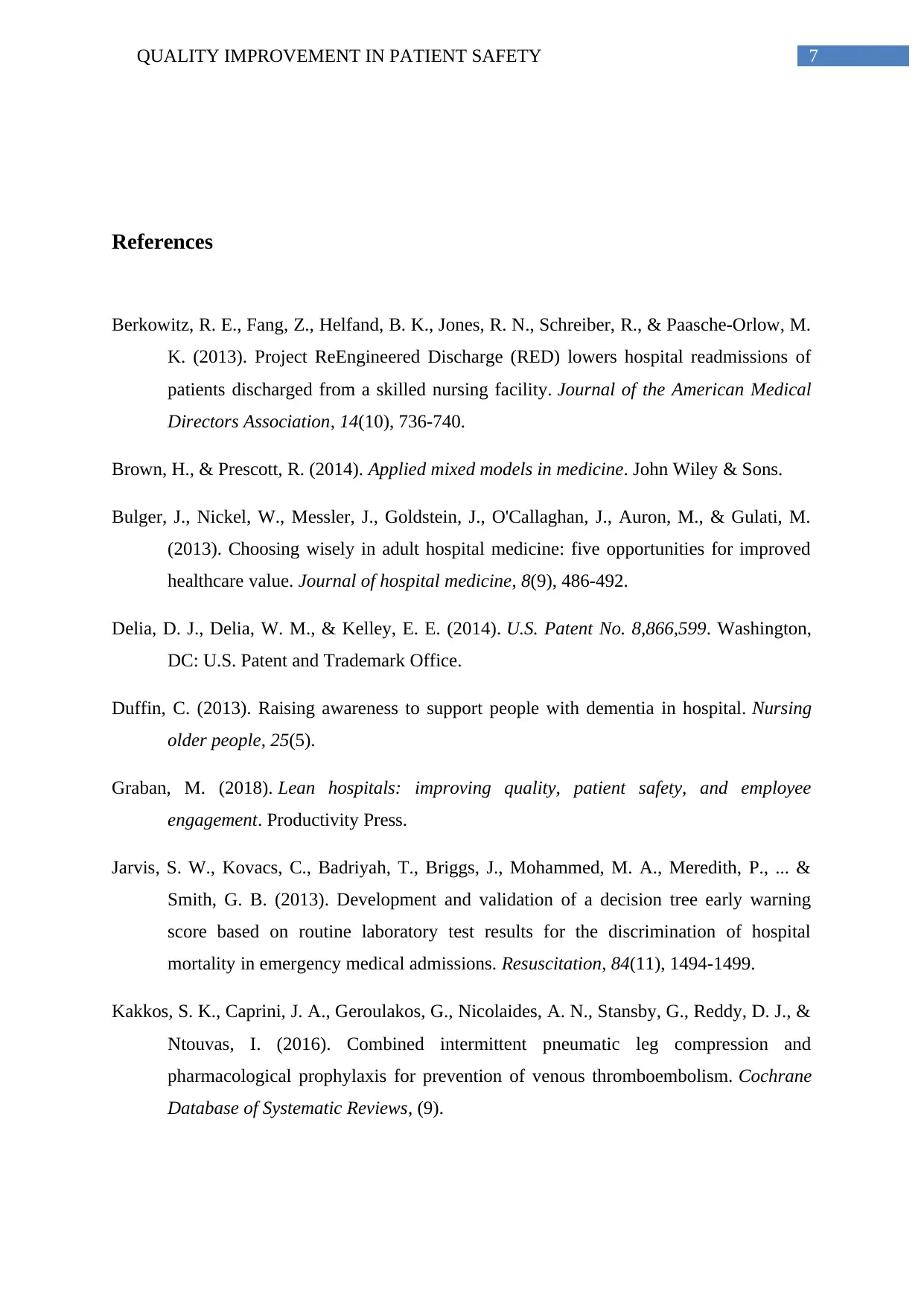
7QUALITY IMPROVEMENT IN PATIENT SAFETY
References
Berkowitz, R. E., Fang, Z., Helfand, B. K., Jones, R. N., Schreiber, R., & Paasche-Orlow, M.
K. (2013). Project ReEngineered Discharge (RED) lowers hospital readmissions of
patients discharged from a skilled nursing facility. Journal of the American Medical
Directors Association, 14(10), 736-740.
Brown, H., & Prescott, R. (2014). Applied mixed models in medicine. John Wiley & Sons.
Bulger, J., Nickel, W., Messler, J., Goldstein, J., O'Callaghan, J., Auron, M., & Gulati, M.
(2013). Choosing wisely in adult hospital medicine: five opportunities for improved
healthcare value. Journal of hospital medicine, 8(9), 486-492.
Delia, D. J., Delia, W. M., & Kelley, E. E. (2014). U.S. Patent No. 8,866,599. Washington,
DC: U.S. Patent and Trademark Office.
Duffin, C. (2013). Raising awareness to support people with dementia in hospital. Nursing
older people, 25(5).
Graban, M. (2018). Lean hospitals: improving quality, patient safety, and employee
engagement. Productivity Press.
Jarvis, S. W., Kovacs, C., Badriyah, T., Briggs, J., Mohammed, M. A., Meredith, P., ... &
Smith, G. B. (2013). Development and validation of a decision tree early warning
score based on routine laboratory test results for the discrimination of hospital
mortality in emergency medical admissions. Resuscitation, 84(11), 1494-1499.
Kakkos, S. K., Caprini, J. A., Geroulakos, G., Nicolaides, A. N., Stansby, G., Reddy, D. J., &
Ntouvas, I. (2016). Combined intermittent pneumatic leg compression and
pharmacological prophylaxis for prevention of venous thromboembolism. Cochrane
Database of Systematic Reviews, (9).
References
Berkowitz, R. E., Fang, Z., Helfand, B. K., Jones, R. N., Schreiber, R., & Paasche-Orlow, M.
K. (2013). Project ReEngineered Discharge (RED) lowers hospital readmissions of
patients discharged from a skilled nursing facility. Journal of the American Medical
Directors Association, 14(10), 736-740.
Brown, H., & Prescott, R. (2014). Applied mixed models in medicine. John Wiley & Sons.
Bulger, J., Nickel, W., Messler, J., Goldstein, J., O'Callaghan, J., Auron, M., & Gulati, M.
(2013). Choosing wisely in adult hospital medicine: five opportunities for improved
healthcare value. Journal of hospital medicine, 8(9), 486-492.
Delia, D. J., Delia, W. M., & Kelley, E. E. (2014). U.S. Patent No. 8,866,599. Washington,
DC: U.S. Patent and Trademark Office.
Duffin, C. (2013). Raising awareness to support people with dementia in hospital. Nursing
older people, 25(5).
Graban, M. (2018). Lean hospitals: improving quality, patient safety, and employee
engagement. Productivity Press.
Jarvis, S. W., Kovacs, C., Badriyah, T., Briggs, J., Mohammed, M. A., Meredith, P., ... &
Smith, G. B. (2013). Development and validation of a decision tree early warning
score based on routine laboratory test results for the discrimination of hospital
mortality in emergency medical admissions. Resuscitation, 84(11), 1494-1499.
Kakkos, S. K., Caprini, J. A., Geroulakos, G., Nicolaides, A. N., Stansby, G., Reddy, D. J., &
Ntouvas, I. (2016). Combined intermittent pneumatic leg compression and
pharmacological prophylaxis for prevention of venous thromboembolism. Cochrane
Database of Systematic Reviews, (9).

8QUALITY IMPROVEMENT IN PATIENT SAFETY
Kirwan, M., Matthews, A., & Scott, P. A. (2013). The impact of the work environment of
nurses on patient safety outcomes: a multi-level modelling approach. International
journal of nursing studies, 50(2), 253-263.
Marschall, J., Mermel, L. A., Fakih, M., Hadaway, L., Kallen, A., O’Grady, N. P., ... &
Yokoe, D. S. (2014). Strategies to prevent central line-associated bloodstream
infections in acute care hospitals: 2014 update. Infection Control & Hospital
Epidemiology, 35(S2), S89-S107.
Mitchell, S. E., Martin, J., Holmes, S., van Deusen Lukas, C., Cancino, R., Paasche-Orlow,
M., ... & Jack, B. (2016). How hospitals reengineer their discharge processes to
reduce readmissions. Journal for healthcare quality: official publication of the
National Association for Healthcare Quality, 38(2), 116.
Moore, S., Shiers, D., Daly, B., Mitchell, A. J., & Gaughran, F. (2015). Promoting physical
health for people with schizophrenia by reducing disparities in medical and dental
care. Acta Psychiatrica Scandinavica, 132(2), 109-121.
Morello, R. T., Lowthian, J. A., Barker, A. L., McGinnes, R., Dunt, D., & Brand, C. (2013).
Strategies for improving patient safety culture in hospitals: a systematic review. BMJ
Qual Saf, 22(1), 11-18.
Nuckols, T. K., Keeler, E., Morton, S., Anderson, L., Doyle, B. J., Pevnick, J., ... & Shekelle,
P. (2017). Economic evaluation of quality improvement interventions designed to
prevent hospital readmission: a systematic review and meta-analysis. JAMA internal
medicine, 177(7), 975-985.
Okuyama, A., Wagner, C., & Bijnen, B. (2014). Speaking up for patient safety by hospital-
based health care professionals: a literature review. BMC health services
research, 14(1), 61.
Parand, A., Dopson, S., Renz, A., & Vincent, C. (2014). The role of hospital managers in
quality and patient safety: a systematic review. BMJ open, 4(9), e005055.
Perakslis, E. D. (2014). Cybersecurity in health care. N Engl J Med, 371(5), 395-397.
Kirwan, M., Matthews, A., & Scott, P. A. (2013). The impact of the work environment of
nurses on patient safety outcomes: a multi-level modelling approach. International
journal of nursing studies, 50(2), 253-263.
Marschall, J., Mermel, L. A., Fakih, M., Hadaway, L., Kallen, A., O’Grady, N. P., ... &
Yokoe, D. S. (2014). Strategies to prevent central line-associated bloodstream
infections in acute care hospitals: 2014 update. Infection Control & Hospital
Epidemiology, 35(S2), S89-S107.
Mitchell, S. E., Martin, J., Holmes, S., van Deusen Lukas, C., Cancino, R., Paasche-Orlow,
M., ... & Jack, B. (2016). How hospitals reengineer their discharge processes to
reduce readmissions. Journal for healthcare quality: official publication of the
National Association for Healthcare Quality, 38(2), 116.
Moore, S., Shiers, D., Daly, B., Mitchell, A. J., & Gaughran, F. (2015). Promoting physical
health for people with schizophrenia by reducing disparities in medical and dental
care. Acta Psychiatrica Scandinavica, 132(2), 109-121.
Morello, R. T., Lowthian, J. A., Barker, A. L., McGinnes, R., Dunt, D., & Brand, C. (2013).
Strategies for improving patient safety culture in hospitals: a systematic review. BMJ
Qual Saf, 22(1), 11-18.
Nuckols, T. K., Keeler, E., Morton, S., Anderson, L., Doyle, B. J., Pevnick, J., ... & Shekelle,
P. (2017). Economic evaluation of quality improvement interventions designed to
prevent hospital readmission: a systematic review and meta-analysis. JAMA internal
medicine, 177(7), 975-985.
Okuyama, A., Wagner, C., & Bijnen, B. (2014). Speaking up for patient safety by hospital-
based health care professionals: a literature review. BMC health services
research, 14(1), 61.
Parand, A., Dopson, S., Renz, A., & Vincent, C. (2014). The role of hospital managers in
quality and patient safety: a systematic review. BMJ open, 4(9), e005055.
Perakslis, E. D. (2014). Cybersecurity in health care. N Engl J Med, 371(5), 395-397.
⊘ This is a preview!⊘
Do you want full access?
Subscribe today to unlock all pages.

Trusted by 1+ million students worldwide

9QUALITY IMPROVEMENT IN PATIENT SAFETY
Rennke, S., Nguyen, O. K., Shoeb, M. H., Magan, Y., Wachter, R. M., & Ranji, S. R. (2013).
Hospital-initiated transitional care interventions as a patient safety strategy: a
systematic review. Annals of internal medicine, 158(5_Part_2), 433-440.
Smith-Miller, C. A., Shaw-Kokot, J., Curro, B., & Jones, C. B. (2014). An integrative review:
fatigue among nurses in acute care settings. JONA: The Journal of Nursing
Administration, 44(9), 487-494.
Spiva, L., Robertson, B., Delk, M. L., Patrick, S., Kimrey, M. M., Green, B., & Gallagher, E.
(2014). Effectiveness of team training on fall prevention. Journal of nursing care
quality, 29(2), 164-173.
Steege, L. M., & Dykstra, J. G. (2016). A macroergonomic perspective on fatigue and coping
in the hospital nurse work system. Applied ergonomics, 54, 19-26.
Viale, P., Tumietto, F., Giannella, M., Bartoletti, M., Tedeschi, S., Ambretti, S., ... & De
Palma, A. (2015). Impact of a hospital-wide multifaceted programme for reducing
carbapenem-resistant Enterobacteriaceae infections in a large teaching hospital in
northern Italy. Clinical Microbiology and Infection, 21(3), 242-247.
Wagner, C., Smits, M., Sorra, J., & Huang, C. C. (2013). Assessing patient safety culture in
hospitals across countries. International Journal for Quality in Health Care, 25(3),
213-221.
Wang, P., Ren, F. M., Lin, Y., Su, F. X., Jia, W. H., Su, X. F., ... & Ren, Z. F. (2015). Night-
shift work, sleep duration, daytime napping, and breast cancer risk. Sleep
medicine, 16(4), 462-468.
Wenger, N., Méan, M., Castioni, J., Marques-Vidal, P., Waeber, G., & Garnier, A. (2017).
Allocation of internal medicine resident time in a Swiss hospital: a time and motion
study of day and evening shifts. Annals of internal medicine, 166(8), 579-586.
Rennke, S., Nguyen, O. K., Shoeb, M. H., Magan, Y., Wachter, R. M., & Ranji, S. R. (2013).
Hospital-initiated transitional care interventions as a patient safety strategy: a
systematic review. Annals of internal medicine, 158(5_Part_2), 433-440.
Smith-Miller, C. A., Shaw-Kokot, J., Curro, B., & Jones, C. B. (2014). An integrative review:
fatigue among nurses in acute care settings. JONA: The Journal of Nursing
Administration, 44(9), 487-494.
Spiva, L., Robertson, B., Delk, M. L., Patrick, S., Kimrey, M. M., Green, B., & Gallagher, E.
(2014). Effectiveness of team training on fall prevention. Journal of nursing care
quality, 29(2), 164-173.
Steege, L. M., & Dykstra, J. G. (2016). A macroergonomic perspective on fatigue and coping
in the hospital nurse work system. Applied ergonomics, 54, 19-26.
Viale, P., Tumietto, F., Giannella, M., Bartoletti, M., Tedeschi, S., Ambretti, S., ... & De
Palma, A. (2015). Impact of a hospital-wide multifaceted programme for reducing
carbapenem-resistant Enterobacteriaceae infections in a large teaching hospital in
northern Italy. Clinical Microbiology and Infection, 21(3), 242-247.
Wagner, C., Smits, M., Sorra, J., & Huang, C. C. (2013). Assessing patient safety culture in
hospitals across countries. International Journal for Quality in Health Care, 25(3),
213-221.
Wang, P., Ren, F. M., Lin, Y., Su, F. X., Jia, W. H., Su, X. F., ... & Ren, Z. F. (2015). Night-
shift work, sleep duration, daytime napping, and breast cancer risk. Sleep
medicine, 16(4), 462-468.
Wenger, N., Méan, M., Castioni, J., Marques-Vidal, P., Waeber, G., & Garnier, A. (2017).
Allocation of internal medicine resident time in a Swiss hospital: a time and motion
study of day and evening shifts. Annals of internal medicine, 166(8), 579-586.
1 out of 10
Related Documents
Your All-in-One AI-Powered Toolkit for Academic Success.
+13062052269
info@desklib.com
Available 24*7 on WhatsApp / Email
![[object Object]](/_next/static/media/star-bottom.7253800d.svg)
Unlock your academic potential
Copyright © 2020–2025 A2Z Services. All Rights Reserved. Developed and managed by ZUCOL.





